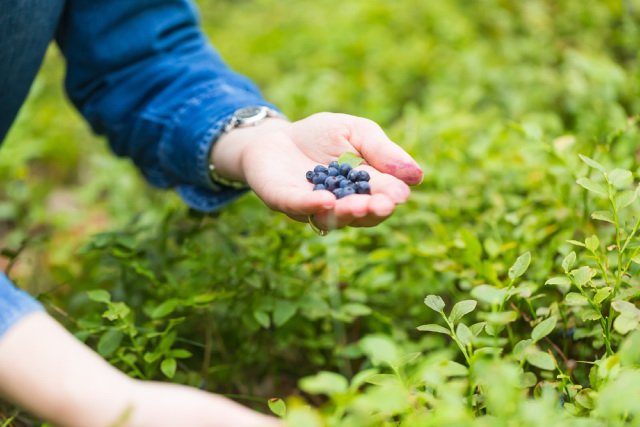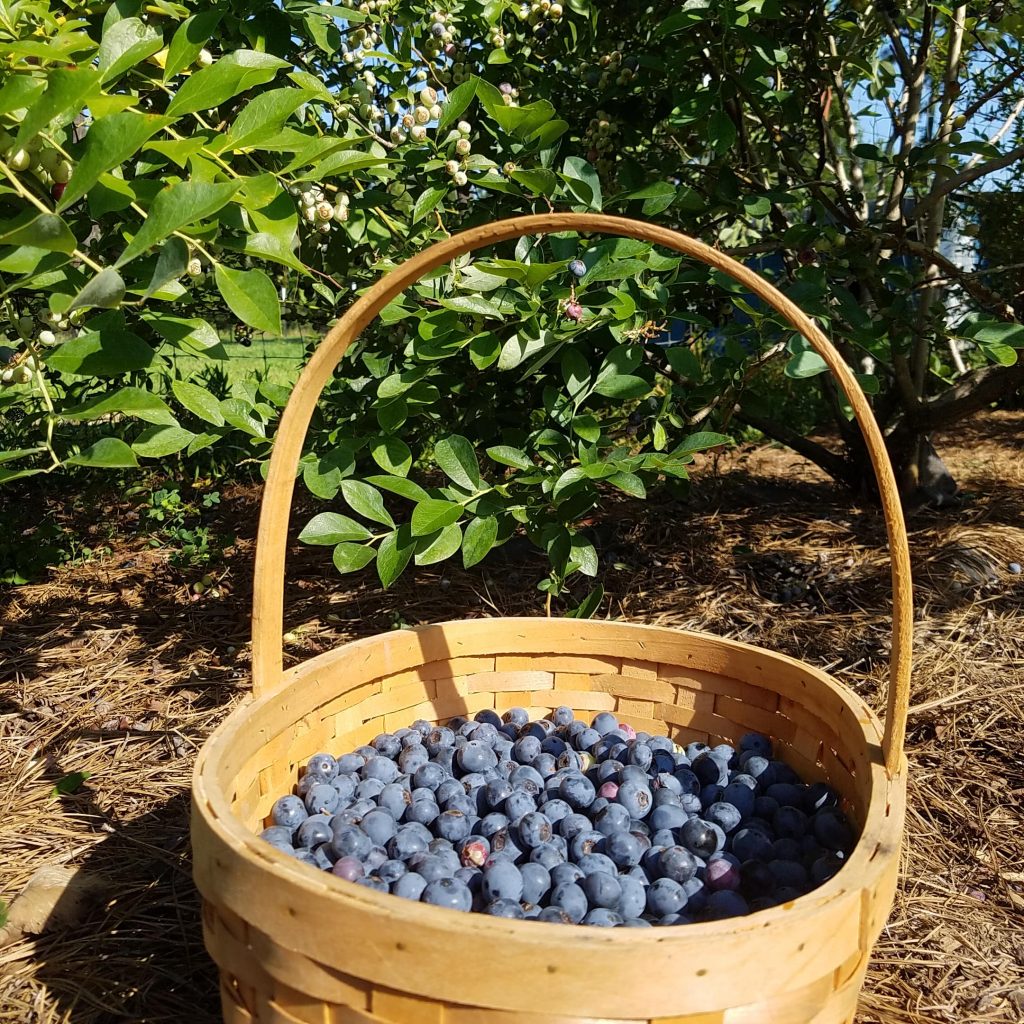When I began gardening in 2013, growing blueberries topped my list of garden priorities. One of the most healthy fruits you can eat, the flavor of store-bought blueberries simply can’t compare to homegrown.
And for those on a budget, growing your own blueberries will save hundreds of dollars over the years compared to buying from the grocery store. If you’re successful, you may find yourself harvesting more than you can eat, and you can sell them to actually earn some extra cash!
Growing plump, juicy blueberries is the dream for many gardeners. But it can be frustrating when your berries stay stubbornly small, no matter what you try. Don’t worry – with a few tweaks, you can get your blueberry bushes pumping out big, sweet berries.
Through trial and error in my own garden I’ve discovered several reasons why blueberries might be undersized. Here are the most common causes along with solutions to help your blueberries reach their full potential.
Soil Acidity
The #1 reason for small blueberries is improper soil pH. Blueberries need highly acidic soil, with a pH between 4.5 and 5.0. Without this, the plants can’t properly take up nutrients, resulting in reduced growth and tiny berries.
Before planting, test your soil’s pH. If it’s too alkaline, amend it with elemental sulfur several months before planting new bushes. For existing bushes, top-dress the soil with acidic organic matter like pine needles or coffee grounds. As a quick fix, try spraying the leaves with an acidic fertilizer containing ammonium sulfate.
Monitor soil pH yearly and continue adding acidic amendments as needed. Getting your soil into the optimal range can take time but it’s crucial for blueberry success.
Watering Issues
Inconsistent watering leads to stressed plants and small berries. Blueberries have shallow roots and need regular moisture.
Aim to provide 1-2 inches of water per week, from rain or irrigation. Mulch around the bushes to conserve moisture. Drip irrigation is ideal to deliver water slowly and directly to the root zone.
Let the soil partially dry between waterings, as too much moisture encourages root rot. Pay extra attention during hot, dry spells.
Insufficient Sunlight
Blueberries crave full sun – at least 6 hours per day. With too little sunlight, plants grow leggy and berries don’t properly ripen.
When planting, choose a sunny, open spot. Prune back overhanging branches and vegetation that could shade the bushes.
Some afternoon shade in hot climates can be beneficial, but aim for mostly unobstructed sun.
Poor Pollination
No pollination = no plump berries! Blueberries won’t set large fruit without adequate pollinator activity.
Plant clusters of at least 2-3 different blueberry varieties within pollinating distance. This boosts cross-pollination for better fruit.
Attract pollinators like bees, butterflies, and hummingbirds with plenty of flowering plants. Avoid pesticides that could harm pollinators.
Consider hand-pollinating using a small brush if natural pollination is insufficient. Act during bloom when the flowers are receptive.
Lack of Fertilizer
Hungry plants equals meager berries. While blueberries are somewhat low-maintenance, they still require regular fertilization to reach peak production.
Use an acidic fertilizer formulated for blueberries, applying in early spring and again after harvest. Organic options like compost, manure, fish emulsion, and pine needles supply nutrients without chemicals.
Pay attention to nitrogen – the first number on fertilizers. Go for ones with an NPK around 5-5-5. Too much nitrogen leads to lush leaves rather than juicy fruit.
Improper Pruning
Letting plants grow wild restricts fruit production. Prune overgrown blueberry bushes to open them up for better light and air circulation.
Prune annually: Remove dead or diseased wood along with small, twiggy growth. Thin congested areas so remaining branches have space to flourish.
Take out older canes to stimulate new growth. Ideal pruning time is late winter through early spring.
Natural Berry Size
Sometimes small berries are simply genetic. Certain blueberry varieties – especially wild types – naturally produce petite fruit.
Check the expected mature size when selecting plants. For plump berries, choose improved varieties like Duke, Spartan, Elliott, or Jersey. Avoid wild, lowbush types if large fruit is desired.
The good news is that while smaller, these berries still pack a flavorful, antioxidant-rich punch! Focus on other traits like taste and plant health rather than just size.
Fixes Take Time
Patience is needed when coaxing plants to optimum production. It can take years to alter soil pH, establish extensive root systems, and find the right care regimen.
Resist the urge to over-prune, over-fertilize, or overwater in hopes of immediate results. Stick to the recommendations and give your berries time to reach mature size.
Enjoy Your Bounty!
When blueberries fail to impress, it’s tempting to get discouraged. But rest assured that with a little TLC and some adjustments, you can get a bountiful harvest of big, juicy berries.
Pay close attention to soil, sun, water, and pruning needs. Rule out variety as a factor. Enlist some pollinator reinforcements.
With the right care, your blueberry bushes will reward you with a summertime feast – berries so plump and sweet, you’ll be glad you didn’t give up!

Mistake #2: Not checking the soil before planting your blueberries
Most garden plants tolerate a variety of pH levels in the soil, but this is not the case with blueberries. Blueberry bushes must have acidic soil — between 4.0 and 5.0 is ideal.
Many garden soils are more likely to swing toward the acidic, particularly in regions like the eastern, southeastern and pacific northwest in the US. But if even if you live in one of those regions, I wouldn’t recommend assuming that’s the case and hoping for the best.
How do you know if your soil is acidic? The safest bet is to test your soil. I use SoilKit (*affiliate link) to test my soil. They mail the testing kit to you with instructions, you take a sample and mail it back in a postage-paid package, and they email you the results within a few days.
(New to soil testing? Here’s more about soil testing — the how and why behind it.)
Mistake #1: Only planting one blueberry bush
Some blueberry cultivars are partially self-pollinating, but some are not. For those that are not (like rabbiteye blueberries commonly grown in the southern US), this means at least two different varieties are necessary to fully pollinate one another. If only one of these bushes is grown, flowers will form but berries will not.
But even partially self-pollinating cultivars (generally northern highbush and southern highbush), planting more than one bush of a different cultivar will yield more berries each year.
Blueberry flowers are pollinated by bumblebees and other bees.
So, regardless of which cultivar you grow, for the best fruit production, you want at least two bushes.
However, I’d suggest planting even more if possible. The more diversity you can include, the better. This is not only the case for abundant fruit set (though that’s a great reason in itself), but different cultivars will flower and set fruit at different times. This can be advantageous for several reasons.

The most obvious is the longer period of harvest. If you have early season, mid season, and late season blueberry bushes, you will be able to harvest for weeks or even months in succession.
When I planted my main blueberry planting, I chose to purchase five different cultivars. Though I didn’t plan it this way, each of them ripens at slightly different times. Not only do I harvest gallons each season from these bushes, but also I harvest for a solid two months.
But there’s another reason why planting cultivars with different ripening times can be advantageous. If your bushes get hit with a late freeze (like mine did — twice — in 2021), the early season cultivar may be the only one affected, whereas you can still count on a large harvest from the later ones.
(Not sure what cultivar to choose? Learn more about which cultivars to choose for your area in this post about growing blueberries in containers or in the ground. )
Why Are My Blueberries So Small?
FAQ
What causes small blueberries?
Blueberries show water stress when the available water reaches 50%. Allowing soils to dry beyond 50% reduces berry size and can cause severe stress.
Why are my blueberries not getting big?
Blueberries require full sun (6 hours or more of direct sunlight per day) to grow and yield well. Plants will grow more slowly and produce less fruit if they are planted in too much shade.
How do you make blueberries bigger and sweeter?
Water. Blueberries like regular irrigation, especially when they have fruit on them. Adequate water makes for bigger berries.
Why are my blueberries small?
However, if you’re finding that your blueberries are smaller than you’d like, you’ll want to know the reason. Woman picking blueberries. The most common reasons blueberries are small are due to the wrong soil pH, a lack of soil nutrients, inconsistent watering, a lack of pruning, or a lack of pollination.
Can blueberries damage your health?
Blueberries have a pleasant, sweet taste. They are often eaten fresh but may also be frozen or juiced. They can be used in a variety of baked goods, jams, and jellies, as well as for flavorings. A half-cup serving of blueberries contains 42 calories, 1 gram protein, 11 grams carbohydrates, and 2 grams fiber. Moreover, blueberries are rich in antioxidants and beneficial plant compounds, including anthocyanins, quercetins, and myricetins. Blueberries will not damage your health, in contrary it may decrease your risk of heart disease, boost brain health, lower blood sugar levels, and improve insulin sensitivity.
Why are my blueberries not growing?
Different cultivars, a change in sun exposure (if a deciduous tree provides more shade later in the season), changes in water as the season goes on, activity of pollinators, etc. I think it is likely due to pruning in the case of your bushes, or the type of wood the berries are growing on. From OSU’s “ Growing Blueberries in Your Home Garden ”:
Why are my berries so small?
Although there are many reasons for small berries including drought and variety selection, a common cause relates to pollination. Poor weather during flowering may inhibit bee flight, causing too few seeds to be produced. Seed number is proportional to berry size. Other causes include:
Why are my Berry buds small?
There are situations where shoot growth is poor (in spring), but flower bud initiation is good (in late summer). It may be that shoots develop lots of flowers with few leaves the following year. Berry size will be small in this case. Shoots develop lots of flowers with few leaves.
How do you know if blueberries are healthy?
You’ll also want to be able to see buds starting to form. The healthiest, fattest blueberries are likely to form on thicker lateral growth, rather than on small, spindly branches. Short, weak laterals can produce fruit, but the blueberries are likely to be smaller and the quality may be impacted.
